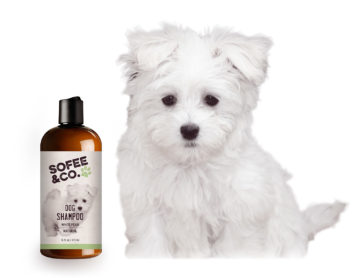
Whether you already own a dog or you’re thinking about adopting one, you probably know that many details come with ensuring a pup’s health and happiness. Sometimes you’re faced with simple issues: Is it time to order more dog food? Should I buy some winter dog booties? Can we find a chew toy that lasts more than two days?
However, sometimes your dog-related decisions are more complicated. Should my dog get spayed? Will my pup get along with a cat? Should I get an electric fence? You want to do what’s best for the safety and long-term health of your furry friend. But it’s challenging to make an informed decision without, well, information. So here is everything you need to know about a crucial pet-related decision: microchipping.
What exactly is a microchip?
A microchip is – unsurprisingly – a thin, tiny chip. Each chip contains a unique ID code and requires no internal power source, meaning it lasts for the life of your dog (or cat). A vet embeds the chip into the loose skin between your pet’s shoulder blades. Don’t worry – it only hurts as much as a standard vaccine.
The vet then scans the chip to ensure the chip is working. Each scanner uses a low radio frequency that won’t hurt your dog. It merely activates the microchip long enough for the microchip to transmit its unique code to the scanner.
Next – and just as importantly – you register your microchip with a microchip company (more on that later). Now your name and contact information are matched to your pup’s unique microchip code.
How microchips work
If your dog goes missing and a friendly stranger finds them, any vet or animal shelter can scan your pet’s microchip. Then they can match your dog’s code to your name and contact information in a registry database and let you know your pet is safe and sound.
Once in place, the microchip stays in your dog for the rest of their life. Therefore, your dog always has a form of identification on them, even if they accidentally lose their collar and tags (or gleefully wriggle free).
Some countries require all dogs to have microchips, including New Zealand, Japan, Northern Ireland, England, Israel, and parts of Australia. The US does not require microchips for dogs.
It’s important to note that microchips are not GPS devices. You can’t track your pup’s location or movement with a microchip. Instead, a microchip works like an ID tag that someone can read after finding your dog. There are a variety of doggy GPS gadgets that you can buy if you’d also like to be able to track your dog’s location in real time. These electronic devices range from the size of a smartwatch to the size of a pocket knife, and they attach to your dog’s collar. Usually, they require a monthly or yearly subscription to maintain their GPS capabilities.
Types of microchips
Most countries use standardized microchips for their pets, specifically ISO-standard microchips (usually the ISO Conformant Full Duplex). These chips are widespread in Oceania, Europe, South America, and Canada. Standardization means that if a German pug gets lost in England, an English vet can still scan the pug’s microchip, find her mom or dad’s information in a database, and get the pug safely reunited with her loved ones.
The microchip market in the US and Africa, o, is a bit more diverse. Pet parents choose between multiple chips: ISO Conformant Full Duplex, Trovan Unique, FECAVA / Destron, and AVID-brand “Friendchip.” As a result, there are multiple scanners on the market – and not all scanners can read all microchips (though universal scanners are gaining popularity.)
If that sounds worrying or overwhelming, don’t worry! The breakdown below spells out specifics about each microchip and makes it clear which type is best for your dog. The decision comes down to you and your dog’s lifestyle. If you live outside of the US and Africa, then an ISO-standard microchip like the ISO Conformant Full Duplex is your best choice. It works with scanners in the greatest number of countries. If your pup isn’t a world traveler, ask around at your local shelters and vet offices to see which types of scanners they have on hand. Then choose a microchip that you know works with local scanners, ensuring that nearby vets and shelters can quickly and easily reunite you with your dog.
(1) ISO Conformant Full Duplex: This is the most widely-used chip in the world, with a standardized 15-digit code in each microchip. However, the ISO Conformant Full Duplex is not the most common chip in the US or Africa, which means some scanners in the US and Africa can’t read these chips. If your dog lives outside of the US or Africa, this is the microchip for him. If your pup spends his dog days in the US or Africa, keep reading.
(2) Trovan Unique: This microchip was initially used in the US, starting in the early ’90s. The market for Trovan dwindled due to patent issues until the American Kennel Club started selling Trovan microchips, popularizing them again. This chip is not as popular outside of the US, but it’s still ISO-compliant, meaning it has a 15-digit code registers on scanners outside of the US. Moreover, in the US, both Trovan and Destron scanners can read these chips. This chip is a good option for US-based pups who might occasionally travel overseas. Again, ask around at your local shelters and vets to ensure that they can scan Trovan microchips before making your decision.
(3) FECAVA / Destron: This type of microchip is for sale in the US under quite a few names, including FECAVA, Destron, Avid Eurochip, and HomeAgain. This particular chip uses a 10-digit code and is widespread across the US since it works with a wide variety of scanners. Scanners in other countries can sometimes read the Destron chip, but it isn’t fully ISO-compliant because it uses a 10-digit code (unlike the ISO-standard 15-digit codes). Destron is a solid choice for homebody American dogs who don’t plan on vacationing abroad. As usual, double check that your local vets and shelters can scan Destron microchips to make reuniting with your dog as easy as possible.
(4) AVID-brand “Friendchip:” The Friendchip wins the award for “Cutest Microchip Name.” This microchip uses a unique 9-character identifier and boasts encryption as an extra security measure. However, like other US-based microchips, the Friendchip can’t be read by all scanners. It is also not ISO-compliant, meaning it doesn’t suffice in countries that require ISO-compliant microchips for dogs. The Friendchip might still be a good option for you if your four-legged friend spends all of her time in the US. Ask your local shelters and vet clinics if they can scan AVID-brand chips, to be sure.
What if you get Fluffy a widely-used US microchip, but suddenly get your dream job in New Zealand, which requires ISO-compliant chips? Don’t worry – if needed, dogs can have two microchips without any problems. You can accept that dream job and get Fluffy an additional ISO-compliant microchip, feeling confident that he’s as safe in Auckland as he was in Austin, Texas.
Even if your pup has a microchip, she should also wear a collar and tags at all times. Tags are her first line of defense if she gets lost. Anyone who finds her can read the tags, whereas a microchip only registers with a scanner at a shelter or vet. However, dogs can lose their collars, whether by accident or on purpose. A microchip guarantees that your dog always has a form of identification on her that can help reunite you if she goes missing.
As microchips continue to grow in popularity, universal scanners (capable of reading any microchip) will also become more common, making it even easier to choose a microchip that works no matter where your dog finds herself.
Are microchips safe?
As with anything medical, there are some risks involved in microchip implantation. A few days of soreness at the injection site is the most common side effect. Sometimes scar tissue develops around the microchip, but the tissue doesn’t hurt your dog, and the chip still registers when scanned.
Usually, your dog’s skin heals around the microchip and keeps it in place. But it’s possible that the microchip could migrate to a different spot in your dog’s body. A migrated microchip won’t hurt your dog, though it might make scanning the chip more difficult – if the chip isn’t between your dog’s shoulder blades when a vet or shelter scans him, it might not register on the scanner. Have your vet check at your regular appointments to make the microchip is in place.
It’s rare, but more serious side effects can happen with microchips. Hair loss, infection, swelling, and tumors have been recorded at microchip sites. Don’t panic – these side effects are notably rare! The British Small Animal Veterinary Association tracks side effects in all microchipped pets, including dogs. They started their database in the ’90s and have studied more than 4 million microchipped pets. Fewer than 400 of those 4 million animals had any negative reaction at all, including the relatively minor issues of swelling and infection. That’s less than 0.01% risk (not 1% – 0.01%).
On the other hand, it’s common for dogs to get lost. As many as 1 in 3 dogs go missing at some point in their life – and only 15-20% of those lost pups ever reunite with their humans. It’s the sad truth that unclaimed dogs in shelters run the risk of being euthanized if no one comes to claim them. Fortunately, dogs with microchips are 2.5 times more likely to be returned home than dogs with no microchips. When you weigh the odds, the answer is clear: It’s much safer for your dog to have a microchip. The odds of your dog getting lost are much higher than the odds of your dog having an adverse reaction to a microchip.
You’re not required to have a vet insert the microchip for you, but it’s your best option. Another health risk with microchips is inferior microchip insertion. Dogs and other animals have been temporarily or permanently maimed by poorly-inserted microchips that pushed on vertebrae or into spinal columns. Don’t take that chance with your dog by inserting the microchip yourself, or by letting an amateur do it! Your local vet is exceptionally skilled at administering vaccinations and can insert a microchip as safely and humanely as possible. Additionally, your vet can scan the chip after insertion to ensure that everything is working as it should.
How to get a microchip for your dog
Fortunately for 21st-century pet parents, microchips are just a Google search and an “add to shopping cart” click away. If you prefer to buy a microchip in person, check with your vet or local animal shelter. Both locations often have microchips on hand and can tell you where to register your microchip after it’s safely in your dog.
Registering your dog’s microchip is just as important as getting it inserted in the first place. Registration connects your name and contact information to the unique ID in your dog’s microchip. When a clinic or shelter scans your dog and enters his ID in a database, your name and phone number appear so they can call and you can retrieve your prodigal pup.
There are various registration companies where you can register online. Some are free, like the Free Pet Chip Registry, where you can register any microchip no matter where you buy it. Others companies, like HomeAgain and AMC, offer paid registration services. In addition to the name and number registration, you get additional bonus features.
The bonus features vary from company to company, but some examples include a “lost pet” alert service, help with making lost pet posters, access to a 24-hour emergency vet hotline for questions and concerns, and even flight or car travel to bring your dog home if she gets lost on vacation or meanders far from home. Prices for these services range from $18 for lifetime registration to $20 per year. Whether or not you pay for these additional features is entirely up to you. Remember that no microchip can locate your dog by itself – a vet or shelter still needs to scan your dog to match her with your information. However, the additional features might be worthwhile for your peace of mind if you know that your dog likes to run off, or if you frequently take your dog on camping trips or vacations outside of your city.
You might notice that an internet search for dog microchips brings up results for microchip kits, including a syringe to inject the microchip into your dog. Nevertheless, don’t try to insert a microchip yourself! As previously mentioned, improper implantation can leave your dog permanently handicapped. Don’t risk damaging your dog’s spine or brain for life! Let a trained vet insert the microchip to minimize pain and risk for your pet.
Conclusion
Microchips are simple, affordable tools that add another line of defense between your dog and homelessness (or euthanization at a shelter). Choose a microchip that fits your lifestyle, can work at local vets and shelters, and meets your country’s microchip requirements (if you live in a country that requires microchips for pets). Your vet can help you choose the right microchip for your dog. Although risks with microchips do exist, the odds of a health complication (0.01%) are so low that microchips remain a valuable addition to your pet’s other health precautions, like a proper diet, exercise, and regular vet visits.
![Best Cheap Dog Foods - our Top 10 Picks of High Quality Brands That Are Still Affordable [Under $1 per pound!] in 2023 Best Cheap Dog Foods - our Top 10 Picks of High Quality Brands That Are Still Affordable [Under $1 per pound!] in 2023](https://shihtzuexpert.com/wp-content/uploads/2018/01/Best-Cheap-Dog-Food-Featured-image.png)
![12 Best Dog Foods for Toy Breeds [Buyer's Guide] 12 Best Dog Foods for Toy Breeds [Buyer's Guide]](https://shihtzuexpert.com/wp-content/uploads/2019/05/3-5.jpg)
![Shih Tzu Poodle mix [Your complete guide to Teddy bear dog | Shih Poo | Shoodle or Pooshi] Shih Tzu Poodle mix [Your complete guide to Teddy bear dog | Shih Poo | Shoodle or Pooshi]](https://shihtzuexpert.com/wp-content/uploads/2020/06/Are-You-a-Good-Match-for-a-Shih-Poo.jpg)

